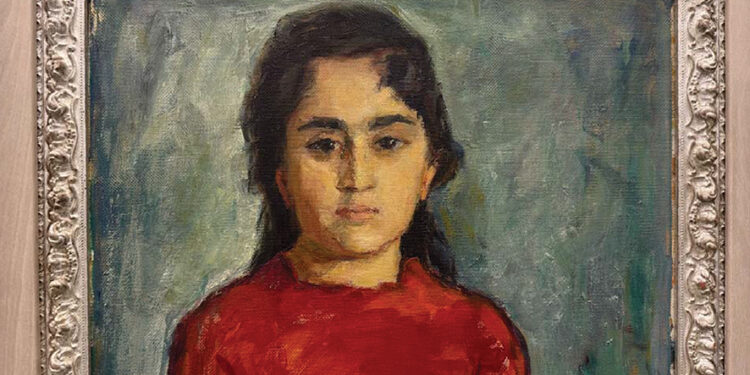The ATINATI Cultural Center is currently hosting a landmark exhibition dedicated to Ketevan Magalashvili (1894–1973), an artist whose work straddles the transition between late 19th-century realism and the modernist impulses of the 20th century. Featuring 19 works drawn from ATINATI’s private collection, this exhibition offers a rare chance to immerse oneself in the diverse artistic world of a painter known primarily as a portraitist, but whose legacy extends far beyond a single genre. The exhibition, open until March 31, 2025, brings long-overdue attention to Magalashvili, a figure who shaped the cultural and aesthetic landscape of Georgian art, but whose contributions remain underexplored outside scholarly circles.

Beyond the Frame: A Visionary in Portraiture
Magalashvili’s foremost artistic preoccupation was portraiture—a genre that, in lesser hands, risks descending into static documentation. Instead, she imbued her subjects with a palpable sense of presence. Each of her portraits is a study in psychological depth, revealing a fascination with identity, emotion, and the unseen dimensions of personality.
What makes Magalashvili’s portraits stand apart is her keen awareness of composition and gesture. The exhibition’s curators emphasize her meticulous attention to bodily posture, gaze direction, and hand positioning—elements that animate her canvases with an almost cinematic dynamism. Unlike many of her contemporaries, who focused predominantly on facial expressions, Magalashvili orchestrated entire compositions to reflect the psychotypes of her sitters. She integrated their surroundings into her works with careful deliberation, ensuring that backgrounds, objects, and even color schemes resonated with the character and essence of the individual.

Mastery of Light and Color: The Invisible Architecture of Expression
A defining characteristic of Magalashvili’s style is her masterful use of light and color. Much like the Impressionists she encountered during her studies in Paris, she understood that light is not merely a tool for illumination but a structural force that sculpts a painting’s emotional core. Her controlled yet vibrant palette allows the interplay of light and shadow to infuse her portraits with life, elevating them from mere representations to dynamic psychological landscapes.
This nuanced use of color extends to her still lifes and landscapes, which, though less widely known, occupy an important place in her oeuvre. The exhibition reveals how Magalashvili experimented with color harmonies to elicit mood, employing bold yet sophisticated contrasts to create visual tension and depth.

The ‘Nude’ Series: A Quiet Revolution
Among the highlights of the exhibition is a selection of Magalashvili’s graphic works in the ‘Nude’ style. These pieces offer a fascinating counterpoint to her more structured portraiture, displaying an unrestrained, fluid approach to the human form. The curatorial notes draw attention to the interplay of line and shadow, reminiscent of both the academic rigor of classical figure drawing and the modernist impulse toward abstraction.
Magalashvili’s engagement with the ‘Nude’ genre was groundbreaking within the Georgian context. In a society where representations of the unclothed body were often fraught with cultural conservatism, her work stands as a quiet act of defiance—an assertion that the human form, in all its vulnerability, deserves artistic contemplation free from moralistic constraints.

The Woman Behind the Canvas: A Life Shaped by Artistic and Political Crosscurrents
Born in 1894 in Kutaisi, Magalashvili’s artistic journey was shaped by a series of geographical and intellectual migrations. Her family relocated to Tbilisi, where she received formal training at the Painting and Sculpture School of the Tbilisi Fine Arts Support Society under the mentorship of Oskar Shmerling, Iakob Nikoladze, Ludwig Longos, Mose Toidze, and Henryk Hryniewski. These formative years imbued her work with a foundation in academic drawing, a discipline that would later serve as a counterbalance to her more expressive tendencies.
Her artistic development continued in Moscow, Germany, and Paris—three cultural capitals where she absorbed diverse influences, from Russian realism to German expressionism and French post-impressionism. These experiences enriched her visual vocabulary, allowing her to synthesize various styles into a uniquely Georgian aesthetic.
Yet, Magalashvili’s career was not insulated from the socio-political upheavals of her time. The Sovietization of Georgia in 1921 brought with it a regime that sought to control artistic expression, steering it towards the propagandistic dictates of Socialist Realism. While some of her peers capitulated or faded into obscurity, Magalashvili navigated these constraints with remarkable resilience, maintaining a personal artistic vision that subtly resisted dogma.

A Legacy in Conservation: Guardian of Georgia’s Artistic Heritage
Beyond her contributions as a painter, Magalashvili played a crucial role in the conservation of Georgian art. As an art conservator at the National Gallery in Tbilisi, she worked tirelessly to preserve the country’s visual heritage, ensuring that seminal works from previous generations remained intact for posterity. This aspect of her career underscores her dual legacy: not only as an innovator in her own right, but also as a custodian of tradition.

Reevaluating Magalashvili’s Place in Georgian Art History
The ATINATI exhibition arrives at a critical moment, as art historians increasingly seek to reappraise the contributions of women artists who were long overshadowed by their male counterparts. While Magalashvili was acknowledged within her lifetime, she was never fully integrated into the dominant narratives of Georgian modernism. This exhibition serves as a corrective, asserting her rightful place within the canon of Georgian and, by extension, European art.
Her work stands as a testament to the power of portraiture—not as mere representation, but as a dialogue between artist and subject, tradition and innovation, personal identity and historical moment.
Magalashvili’s art resonates with contemporary audiences precisely because it addresses universal themes: the search for identity, the fluid boundaries between realism and abstraction, and the enduring power of the human gaze. Her insistence on capturing the psychological essence of her subjects rather than merely their likeness anticipates modern debates about portraiture’s role in an age of digital self-representation.
By Ivan Nechaev














